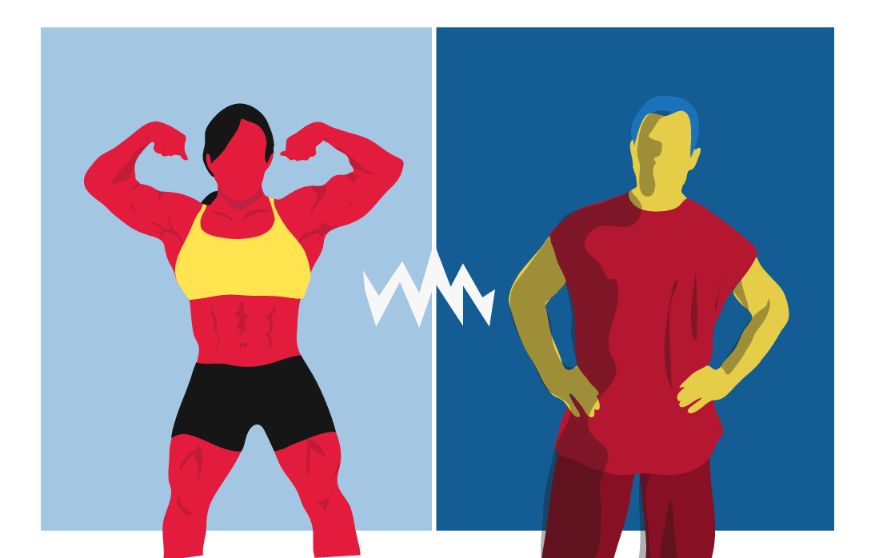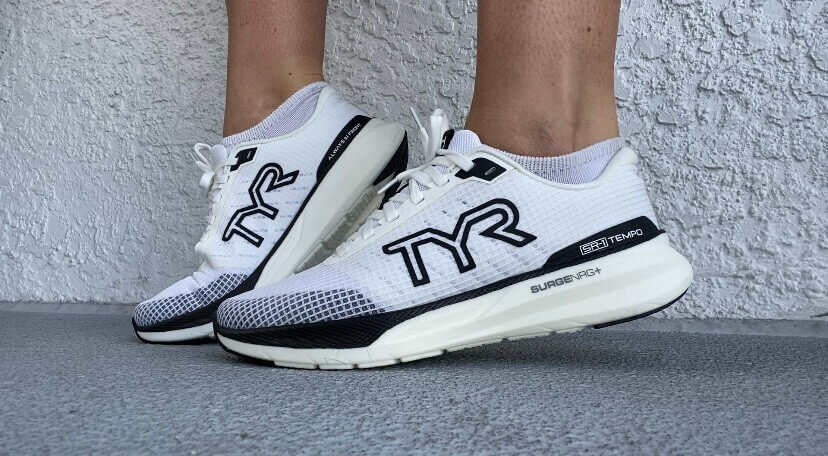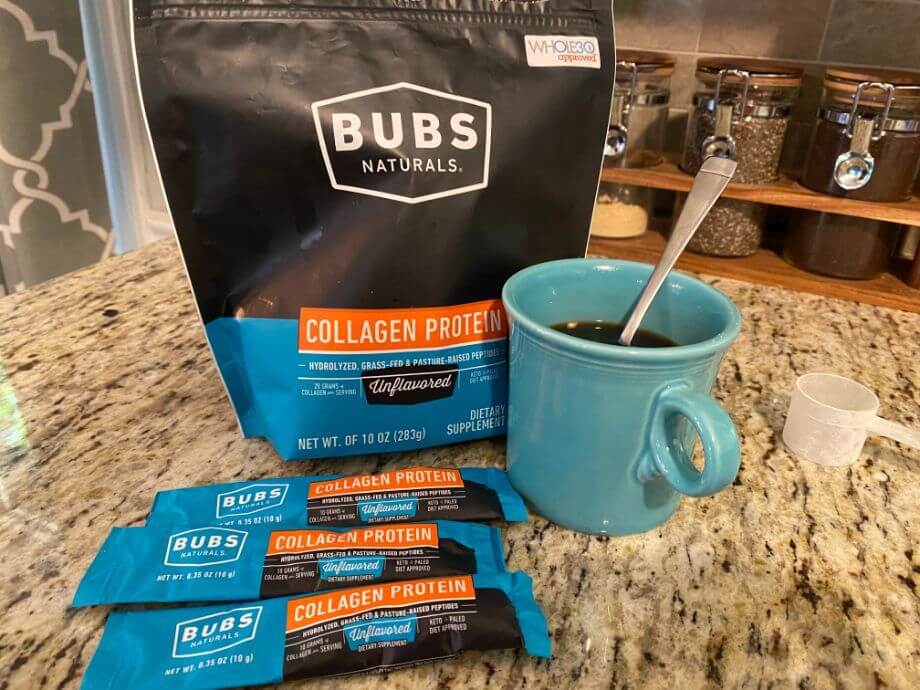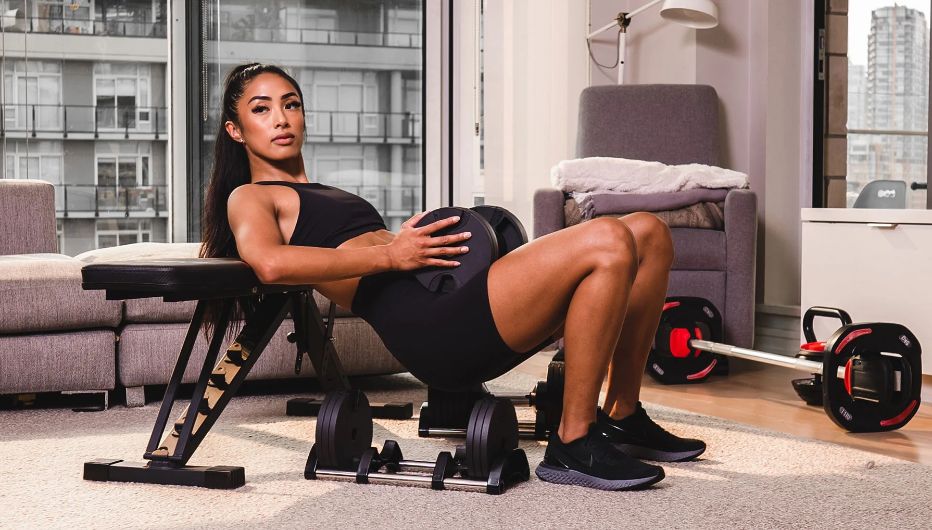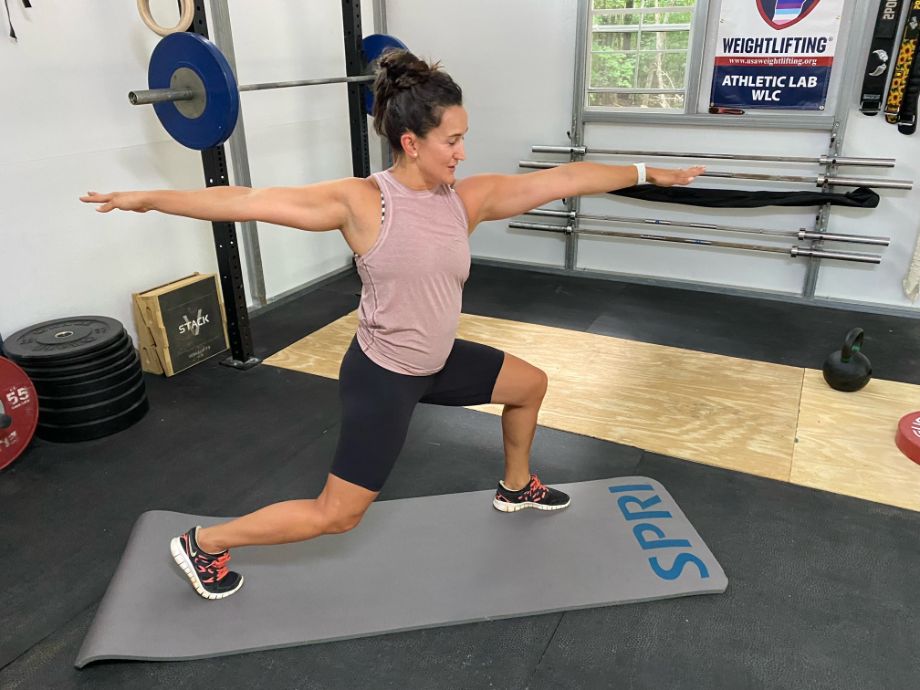Medical Disclaimer : All information in this piece is for informational purposes only. You should not use it to replace any professional medical advice, diagnosis, or treatment of health issues. Any questions about your health should be directed toward a physician or licensed healthcare professional.
For this piece, we reached out to sports doctor Mike Masi, a physical therapist, certified sports nutritionist, and Garage Gym Reviews expert panelist.
It’s bulking season. Or is it cutting season? Trying to figure it out can sometimes be confusing, but unlike winter or summer bulking and cutting don’t have to come at specific times of the year. Most people bulk during the winter (you have to fit into those puffy coats somehow) and cut during the warmer months to look lean on the beach, but you could really do either whenever you want.
As with anything else, you need to know how to properly do both. Bulking and cutting may sound simple on the surface, but lacking vital information on them can lead to stalled progress and set your fitness goals back by quite a bit.
That’s why we’ve put together this handy guide on bulking and cutting, and enlisted the help of certified sports nutritionist Dr. Mike Masi, a doctor of physical therapy and Garage Gym Reviews expert panelist.
He’ll help break down what the two seasons are all about and give you some tips on how to make sure you nail your bulk, or have a successful cut.
RELATED: Best protein powder for men
Bulking and Cutting: What Does It Mean and How Does It Work?
Before we get into the how, let’s discuss a little bit of what each season actually entails. We asked Dr. Mike to give us his professional definition of both. Here’s what he had to say:
- Bulking: “Bulking is a prolonged period of putting on muscle mass, while at the same time mitigating any fat mass accumulation.”
- Cutting: “Cutting is a plan executed over a prolonged period of losing weight, preferably body fat, while maintaining muscle mass.”
Now those are the Cliff Notes version of each, and there’s more to it than just making your frame bigger or smaller. Let’s go a little more in-depth into both.
Bulking 101: Understanding the Benefits, Nutrition, and Workouts for Bulking
Bulking is sometimes referred to as the act of putting on a “winter coat,” another reason why people often do it during the colder months (plus, more mass means more body heat). And we want that coat to be made of muscle and not fat.
Benefits of Bulking
Bulking almost always has an aesthetic undertone to it, Dr. Mike says, but becoming more muscular isn’t the only reason why someone might choose to bulk. They might also use it to become stronger.
“Mass moves fast,” Dr. Mike says. Now, that’s not to say smaller people can’t perform incredible feats of strength (it’s been done many times), but it’s true that the larger a person is the more weight they can move.
The goal is to put on more muscle than fat, but you will gain some of the latter. By eating the right types of food and focusing on steady and slow progress, you can make sure it’s not too much.
What a Bulking Plan Looks Like
If you’ve ever watched one of those “What I Eat in a Day” YouTube videos, you might be under the impression that bulking is just about eating bowls of cereals and double cheeseburgers in an effort to get in as many calories as possible. This is what’s referred to as a “dirty bulk,” and it often results in excess fat gain.
So what should you eat?
RELATED: Best protein chips
“Try to make 80 percent of your diet fruits, vegetables, lean meats, whole grains, and healthy fats,” Dr. Mike says. The other 20 percent can be foods you like–a piece of chocolate and a small glass of wine, one scoop of ice cream, or a side of onion rings (keyword there being “or”).
The 80/20 rule makes it so the diet isn’t restrictive, which allows people to feel like they’re not being restricted and increases the chance that they’ll stick to the diet and not sabotage it by binging on their favorite junk food. It’s all about moderation.
That leads us into the question of how much should one eat while trying to bulk? Well, that depends on a few factors. For one you have to figure out what your baseline is, or the amount of calories you need to sustain your weight based on your current activity level. For that, you can use a calorie calculator.
Next you’ll want to create an eating plan that puts you in a caloric surplus, or a state where you consume more calories than you use throughout the day. How much of a surplus you should be in depends on how long you want to bulk for, and to determine that we need to do some quick math.
There are 3,500 calories in a pound and seven days in a week. If your daily caloric surplus is 500 calories, you’ll gain 1 pound a week. If it’s 250, you’ll gain half a pound a week.
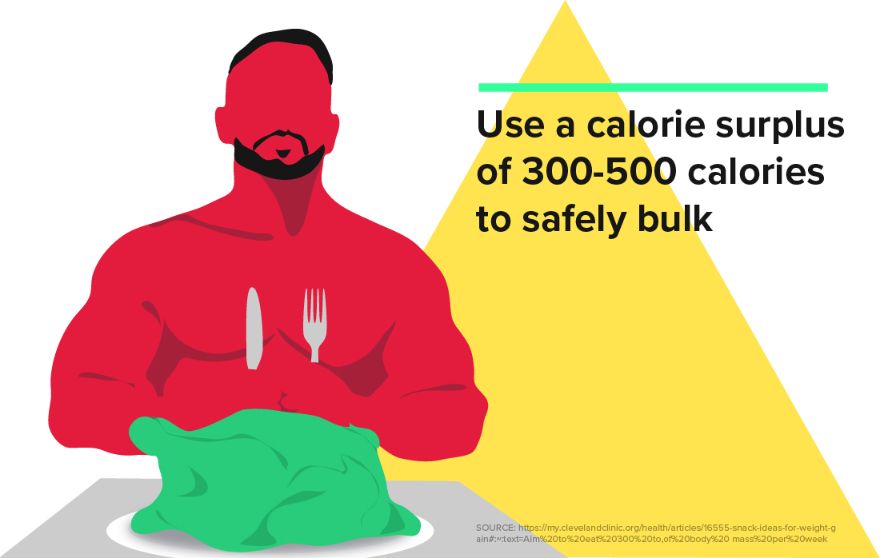
Dr. Mike recommends not going above a surplus of 500 calories a day. “Anything above that and you’ll start gaining more fat mass than you probably want.”
RELATED: Best protein bars
Bulking Exercises
There’s a misconception that you need to do different exercises during a bulk than you would during a cut, and that’s not true. That said, bulking is the time when you want to put on more muscle, so you’ll want to do more strength training during this time to take advantage of that.
Focus on compound movements like the bench press, deadlift, squat, military press, and pull-up. You’ll gain strength by doing low reps with moderately-heavy weight (about 70-80 percent of your 1-rep max), and muscle by doing high reps with moderate weight.
Oh, there’s one other myth we should bust: that you don’t do cardio while trying to bulk. You should absolutely do cardio while bulking to keep your heart healthy and make sure your endurance doesn’t suffer.
Here’s an example of a bulking workout centered around building strength:
- Deadlift, three sets of five reps
- Barbell bent-over rows, three sets of eight reps
- Dumbbell curls, three sets of 12 reps
- Pull-ups, three sets of six reps
You can read more on how to program your own home workouts.
RELATED: Best Online Workout Programs
Cutting 101: Understanding the Benefits, Nutrition, and Workouts for Cutting
Bulking season is when you put on mass, and cutting season is when you chisel it to get the physique you want. But that mass can’t come at the expense of our hard-earned gains. “We want to figure out how we can now lose some of our body fat without sacrificing what we just worked for,” Dr. Mike says.
Benefits of Cutting
It goes without saying, but one of the biggest benefits of cutting is that you start to look like a Baywatch lifeguard (or at least that’s the goal). The word “chiseled” is used because it’s similar to sculpting a piece of marble into a statue–you want to chip away at some of the mass, while still leaving the overall figure rock-hard.
RELATED: Best-tasting protein powder
There is a trade-off, though. “People have this idea that they’re going to keep bench pressing the same weight while they’re cutting,” Dr. Mike says. And while you’re not going to lose all of your strength gains, the loss of mass is going to result in you not being able to move a barbell quite as quickly as you could when you were 10 pounds heavier.
On the plus side, since you’re losing weight you’ll start to see improvement in certain health markers such as blood sugar levels, blood pressure, and insulin sensitivity.
What a Cutting Plan Looks Like
A cutting nutrition plan doesn’t look much different than a bulking one. You’ll still want 80 percent of your diet to come from fruits, vegetables, lean meats, whole grains, and healthy fats and the other 20 percent to come from whatever you like. You’re just eating less of it…well, not necessarily.
It is true that during cutting you want to be in a caloric deficit, or burning more calories than you consume during the day. But that doesn’t mean you need to eat less than what you’re consuming right now.
“You can keep your diet consistent and still lose weight,” Dr. Mike says.
RELATED: Best organic protein powder
To understand how, we need to dive into the equation of calories in vs. calories out. Calories in is simple: It’s how many calories you eat in a day, and that entails the cream you put in your coffee to the peanut butter you lick off the spoon after making your PB&J (yes, that counts).
Calories out is how many calories you expend during the day and it can be broken down into three categories, the first being the thermic effect of food, or how much energy your body needs to fully digest what you’ve eaten. Protein-rich and spicy foods have higher thermic effects than most other foods, but this category only accounts for about 10 percent of the “calorie out” equation so the best protein powder for weight loss isn’t going to be a magic key.
The second is exercise activity thermogenesis, or working out. These are calories we burn while running, lifting weights, or on a rowing machine. Most people might focus on this, but it actually only accounts for 20-30 percent of “calories out.”
RELATED: Rowing vs Running
The biggest part of calories out comes from what’s known as non-exercise activity thermogenesis, known as NEAT. This is everything from walking to work, standing for extended periods of time, yard work, carrying loads of laundry up and down the stairs or to a laundromat, and everything else in between. This accounts for 70 percent of “calories out” and it’s where you can make the biggest difference.
So if you’re trying to get into a caloric deficit, you might want to stand at a desk rather than sit at it, or take the stairs as opposed to the elevator. Even the act of fidgeting counts as NEAT, and can help you burn hundreds of calories a day. These small decisions may not seem like much but they do add up and can tip the scales in your favor.
It’s important to note there is also something called basal metabolic rate, or the amount of calories you need to sustain basic life functions such as regulating your internal temperature. It’s different from your baseline calorie intake, which is what you need to maintain your current weight based on your activity level.
Cutting typically lasts longer than bulking because you want to keep your daily deficit around the 250 mark. “Anything below that and you start to lose muscle mass in addition to fat, and you sacrifice all that you worked for,” Dr. Mike says.
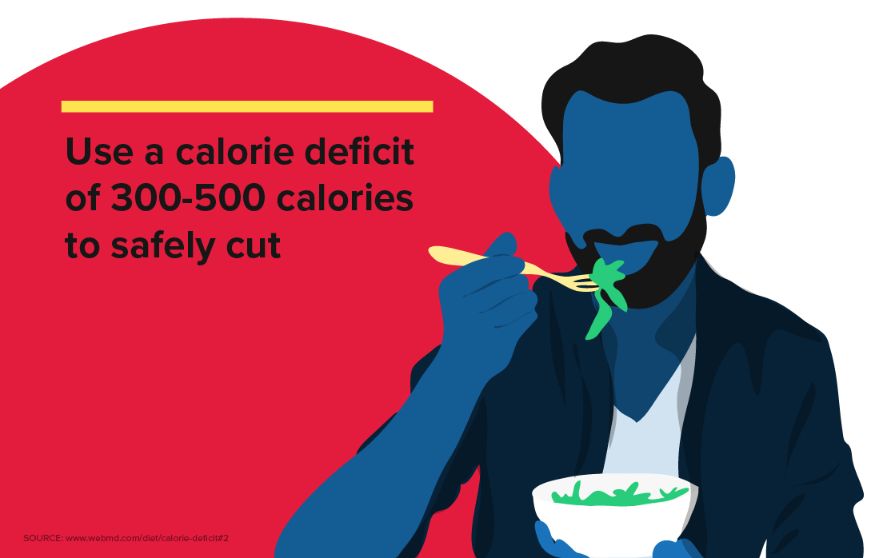
This means you’ll be losing about half a pound a week, so make sure to start your cut well before you intend to reach your target weight. For example, if you want to lose 10 pounds, it will take you about 20 weeks to do so on a cut. You can, under close supervision, have a caloric deficit of around 500 calories per day to speed up the process, but know that means you’ll feel hungrier and might require some extra dedication.
Cutting Exercises
Again, you can still do the same exercises you did on a bulk during a cut. You just won’t have as much strength so you should focus more on muscle-building exercises (high reps with moderate weight), which will not only help you burn calories but also preserve as much muscle mass on your frame as possible.
Adding more bouts of cardio can also be an effective way to reach your caloric deficit. To that end, it might be a good idea to spend some time on an elliptical or do plenty of HIIT workouts.
A great example of a cutting workout is “The Coop” CrossFit WOD, which was published on WODWell. It’s guaranteed to get your heart pumping while working your muscles hard. Feel free to adjust the weight if you need. Here’s what it looks like:
21-15-9 reps of:
- Pull-ups
- Bench presses (135/95 lbs.)
Rest three minutes
9-15-21 reps of:
- Push-Ups
- Deadlifts (225/155 lbs.)
Complete 21 Pull-Ups, 21 Bench Presses, 15 Pull-Ups, 15 Bench Presses, 9 Pull-Ups, 9 Bench Presses. Look at the clock and rest for three minutes. Then do 9 Push-Ups, 9 Deadlifts, 15 Push-Ups, 15 Deadlifts, 21 Push-Ups, and 21 Deadlifts.
Advice From the Experts on How to Get Started
Tip 1: Track, Track, Track
Whether you’re bulking or cutting, you want to track the amount of calories you take in and how many you put out to make sure you’re in a proper deficit or surplus. To track how many calories you burn, you can enlist the help of one of the best fitness trackers on the market. Use an app like MyFitnessPal to track how many calories you eat throughout the day.
On that note, pay attention to serving sizes. What you think is a serving of peanut butter vs. an actual serving is often two different things, and an extra 190-calorie scoop can make or break your progress (but remember it’s not the end of the world if you slip up).
Tip 2: Hit Your Macros
When you find out how many calories you need per day, you’ll want to split it up into the three different macronutrients: protein, carbohydrates, and fats. Carbs should be 45-60% of your daily calories, protein should be 25-35%, and fats should be 25-35%. These are ranges, so find the best that works for you.
Before any of that, however, you should ask yourself, “How much protein do I need?” so you can set yourself up for success.
And as Dr. Mike points out, make sure these are healthy forms of these macronutrients. Pick whole grain breads over white bread, lean cuts of meat over fatty, and healthy fats like avocados over trans fat. Again, you do get to have some treats but they should only account for 20% of your diet.
RELATED: High Protein Foods
Tip 3: Don’t be Afraid of Change
It’s good to have a plan, but you might find that midway through your cut or bulk that some things might not work for you. Maybe you need more protein to stay fuller for longer, or you need to hit the gym more often.
Even professional bodybuilders change their routines while prepping for competition. If something’s not working for you, then change it.
RELATED: Our Expert-Reviewed Picks for Best Protein Powder
Tip 4: Stay Informed
Visiting this page is a great first step in educating yourself on bulking and cutting, but if you feel the need to do some more research make sure to vet the information you read.
“You can’t fall for everything you read on the internet,” Dr. Mike says, repeating the phrase you probably heard a million times from your parents. But they’re right. Cross-reference anything you might read (us included) with other resources on the web.
This can include government websites (like the Centers for Disease Control and Prevention or the U.S. Food and Drug Administration), education centers (Harvard School of Public Health), peer-reviewed scientific studies, and licensed professionals (such as Dr. Mike).
Final Takeaways
Remember, professional bodybuilders have a team of dietitians, personal trainers, and other professionals at their disposal during their bulks and cuts. Most home gym owners won’t be able to afford those services so if you decide to bulk or cut you need to be diligent and patient. Here are a few things to keep in mind.
- Use a calorie calculator to determine your caloric targets
- Track your food intake with apps like MyFitnessPal, and calories burned using a fitness tracker
- Make 80 percent of your diet fruits, vegetables, whole grains, lean meats, and healthy fats
- The other 20 percent can be whatever you want
- Focus on muscle-building workouts during bulks and cuts
- Make sure to do cardio, even if you’re bulking
RELATED: Best protein powder for women
FAQs on Bulking and Cutting
Is bulking better than cutting?
That depends on your goal. If you’re looking to gain muscle and strength, then bulking is the better plan for you. If you’re looking to have a more toned physique, then you want to go on a cut.
How long should I bulk before cutting?
That depends on how much muscle you’re looking to gain. With an intelligently-designed bulk plan you can gain one-half to one pound per week, but you should only lose a half a pound per week on a cut.
What is the difference between bulk and cutting?
Bulking is when you intentionally gain weight, preferably muscle mass with little fat. Cutting is when you lose fat while trying to mitigate muscle loss.
Does bulking make you fat?
The purpose of bulking is to gain muscle mass, but you will unavoidably gain some fat. The goal is to make it as little as possible and that’s why it’s recommended your caloric surplus is no larger than 500 calories.


